Difference between revisions of "Template:OpenWrt1"
(updated by API) |
(updated by API) |
||
| Line 301: | Line 301: | ||
{{#switch: {{{1}}} | {{#switch: {{{1}}} | ||
| − | | NanoPi-R1 = | + | | NanoPi-R1 = |
| − | === | + | ===查看LED的配置=== |
| − | * | + | * 登录OpenWrt-LuCI界面后,点击顶部的 System ---> LED Configuration,可以查看当前LED的功能配置: <br> |
[[File:R1_openwrt_led.png|frameless|600px|R1_openwrt_led]] <br> | [[File:R1_openwrt_led.png|frameless|600px|R1_openwrt_led]] <br> | ||
| − | * | + | * 默认LED的功能配置如下: |
| − | : | + | LED1: 系统心跳灯,如果该LED不闪烁了,则表示系统死机了,必须断电重启系统。<br> |
| − | + | LED2: 千兆以太网eth0 WAN口的状态灯,如果WAN口网线连接正常,则LED亮,反之则LED灭。用户可以通过勾选复选框"Transmit" / "Receive"以设置当发送 / 接收到数据时LED闪烁。<br> | |
| − | + | LED3: 百兆以太网eth1 LAN口的状态灯,如果LAN口网线连接正常,则LED亮,反之则LED灭。用户可以通过勾选复选框"Transmit" / "Receive"以设置当发送 / 接收到数据时LED闪烁。<br> | |
| − | + | * 相关参考: | |
| − | + | ||
| − | + | ||
| − | + | ||
| − | + | ||
| − | + | ||
| − | * | + | |
** [https://openwrt.org/docs/guide-user/base-system/led_configuration openwrt led_configuration] | ** [https://openwrt.org/docs/guide-user/base-system/led_configuration openwrt led_configuration] | ||
}} | }} | ||
{{#switch: {{{1}}} | {{#switch: {{{1}}} | ||
| − | | NanoPi-R1 = | + | | NanoPi-R1 = |
| − | === | + | ===查看BUTTON的配置=== |
| − | + | 本OpenWrt系统使用软件包triggerhappy配置按键的功能,默认的配置为按下按键就会触发系统执行reboot操作。 | |
| − | + | 如果系统发生了异常需要重启,建议使用该按键触发软件reboot,这样可以有效地避免由于断电而造成的文件系统损坏的问题。<br> | |
| + | triggerhappy对应的配置文件为/etc/triggerhappy/triggers.d/example.conf。 | ||
| − | * | + | * 相关参考: |
** [https://openwrt.org/docs/guide-user/hardware/hardware.button openwrt hardware.button] | ** [https://openwrt.org/docs/guide-user/hardware/hardware.button openwrt hardware.button] | ||
}} | }} | ||
Revision as of 09:52, 5 May 2019
Contents
[hide]1 Work with OpenWrt
1.1 Introduction
OpenWrt is a highly extensible GNU/Linux distribution for embedded devices.Unlike many other distributions for routers, OpenWrt is built from the ground up to be a full-featured, easily modifiable operating system for embedded devices. In practice, this means that you can have all the features you need with none of the bloat, powered by a modern Linux kernel. For more details you can refer to:OpenWrt Website.
1.2 System Login
- 串口登录
如果您需要进行内核开发,最好选购一个串口配件,连接了串口,则可以通过串口终端对开发板进行操作。
使用串口模块能有效地提升开发效率,以下是串口模块的连接方法:
接上串口后,您可以选择从串口模块的DC口或者从MicroUSB口 (如果有) 进行供电。
也可以使用USB转串口模块调试,请注意需要使用5V/2A电源给开发板MicroUSB供电。
默认会以 root 用户自动登录,并且没有设置root用户的密码,你可以使用 passwd 命令来设置 root 用户的密码。
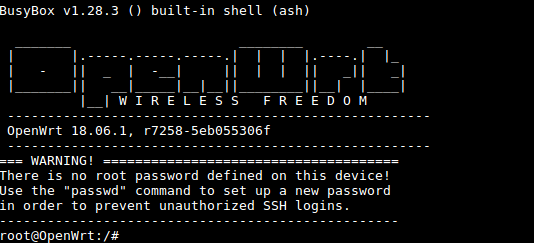
第一次运行系统时,系统会自动拓展TF卡上文件系统分区到最大可用空间:
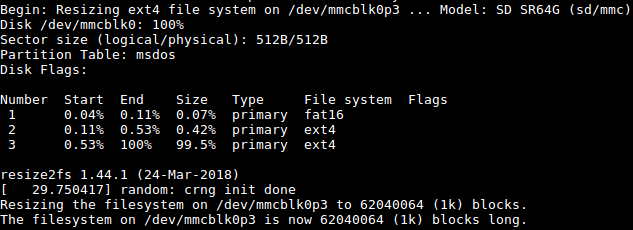
请耐心等待文件系统扩展完成。
- SSH登录
- Web登录
OpenWrt系统支持通过LuCI Web界面进行访问和配置。
默认用户名为root,无需密码,直接点击"Login"按键即可登录。
1.3 Manage Software Packages
OpenWrt has a package management utility: opkg. You can get its details by running the following command:
$ opkg
Package Manipulation:
update Update list of available packages
upgrade <pkgs> Upgrade packages
install <pkgs> Install package(s)
configure <pkgs> Configure unpacked package(s)
remove <pkgs|regexp> Remove package(s)
flag <flag> <pkgs> Flag package(s)
<flag>=hold|noprune|user|ok|installed|unpacked (one per invocation)
Informational Commands:
list List available packages
list-installed List installed packages
list-upgradable List installed and upgradable packages
list-changed-conffiles List user modified configuration files
files <pkg> List files belonging to <pkg>
search <file|regexp> List package providing <file>
find <regexp> List packages whose name or description matches <regexp>
info [pkg|regexp] Display all info for <pkg>
status [pkg|regexp] Display all status for <pkg>
download <pkg> Download <pkg> to current directory
...These are just part of the manual. Here are some popular opkg commands.
- Update Package List
Before you install a package you'd better update the package list:
$ opkg update
- Check Available Packages
$ opkg list
At the time of writing there are 3241 packages available.
- Check Installed Packages:
$ opkg list-installed
At the time of writing 124 packages have been installed.
- Install/Delete Packages:
$ opkg install <pkgs> $ opkg remove <pkgs>
- Check Files Contained in Installed Packages:
$ opkg files <pkg>
- Install Chinese Language Package for LuCI
$ opkg install luci-i18n-base-zh-cn
- Check Changed Files:
$ opkg list-changed-conffiles
- Reference Links:
1.4 查看系统状态
- 命令行查看CPU温度和频率
$ cpu_freq
Aavailable frequency(KHz):
480000 624000 816000 1008000
Current frequency(KHz):
CPU0 online=1 temp=26548C governor=ondemand freq=624000KHz
CPU1 online=1 temp=26548C governor=ondemand freq=624000KHz
CPU2 online=1 temp=26548C governor=ondemand freq=624000KHz
CPU3 online=1 temp=26548C governor=ondemand freq=624000KHz上述信息表示当前有4个CPU核在线, 温度均约为26.5摄氏度, 运行的策略均为根据需求来决定运行频率, 当前的运行频率均为624MHz,设置频率的命令如下:
$ cpu_freq -s 1008000
Aavailable frequency(KHz):
480000 624000 816000 1008000
Current frequency(KHz):
CPU0 online=1 temp=36702C governor=userspace freq=1008000KHz
CPU1 online=1 temp=36702C governor=userspace freq=1008000KHz
CPU2 online=1 temp=36702C governor=userspace freq=1008000KHz
CPU3 online=1 temp=36702C governor=userspace freq=1008000KHzThese messages mean four CPU cores are working online. Each core's temperature is 26.5 degrees. Each core's governor is on demand and the frequency is 480 MHz.
- OpenWrt-LuCI Web界面查看系统状态
登录OpenWrt-LuCI界面后,点击顶部的 Statistics ---> Graphs,可以查看系统的各种软硬件状态信息(即statistics),例如:
1) System Load:
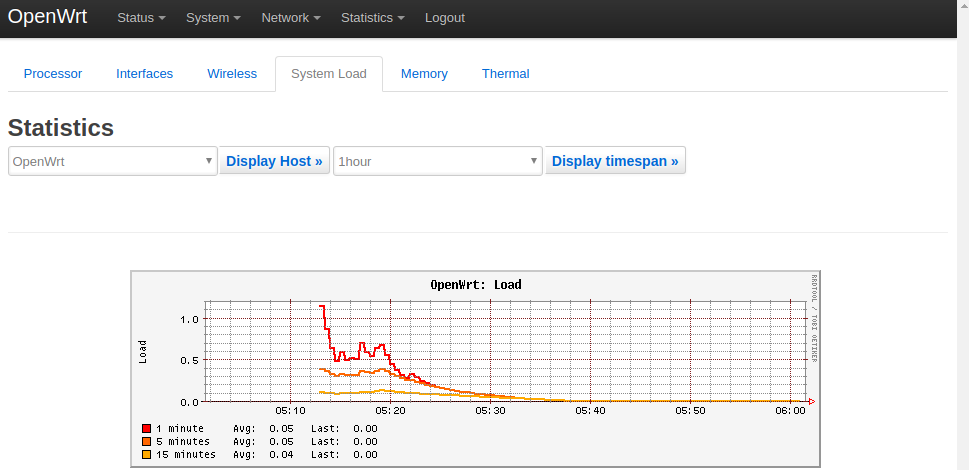
2) RAM:
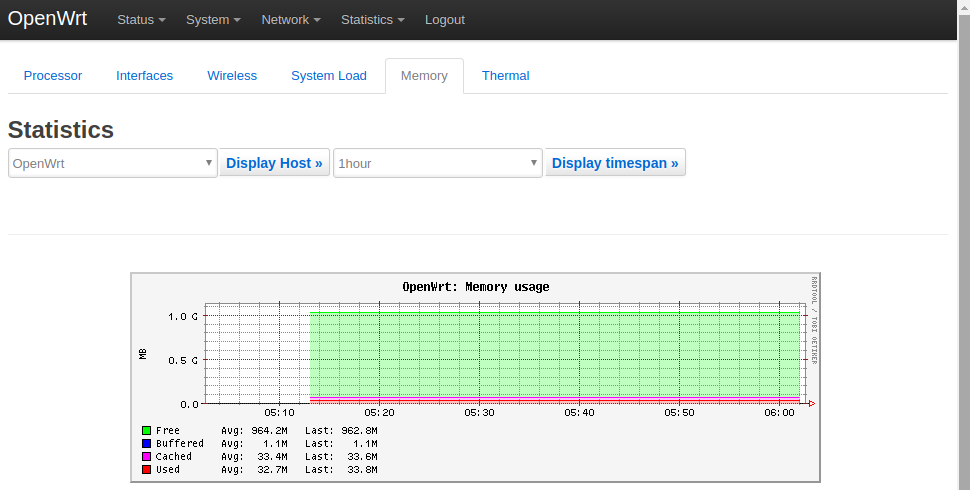
3) CPU Temperature:
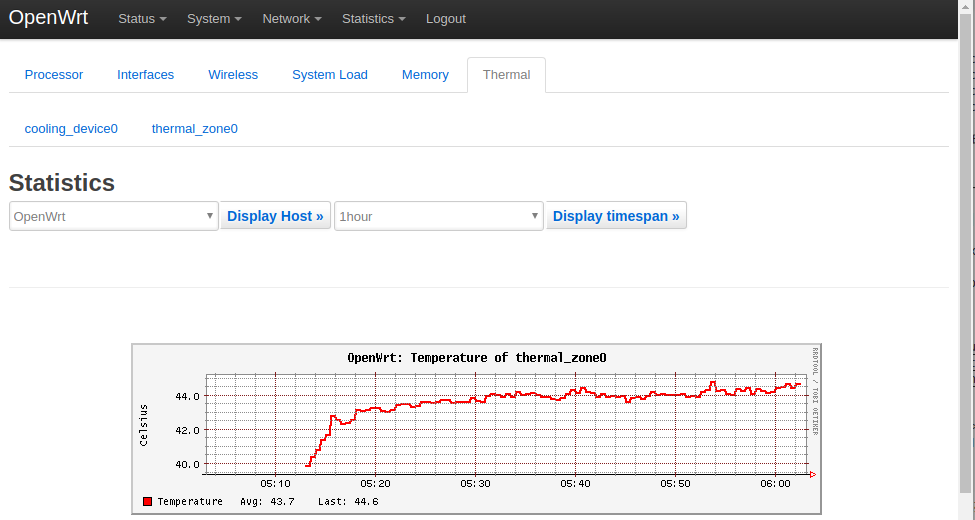
Statistics界面对应软件包luci-app-statistics,luci-app-statistics软件包用Collectd工具收集状态数据并且用RRDtool工具将数据渲染为图表。
你可以通过安装额外的collectd-mod-*软件包去使能更多的statistics.
All collectd-mod-* packages use the same configuration file: /etc/config/luci_statistics.
- Reference Links:
1.5 查看Network->Interfaces的配置
- 登录OpenWrt-LuCI界面后,点击顶部的 Network ---> Interfaces ,可以查看当前的网络设置:
- Network->Interfaces界面的配置保存在/etc/config/network中。